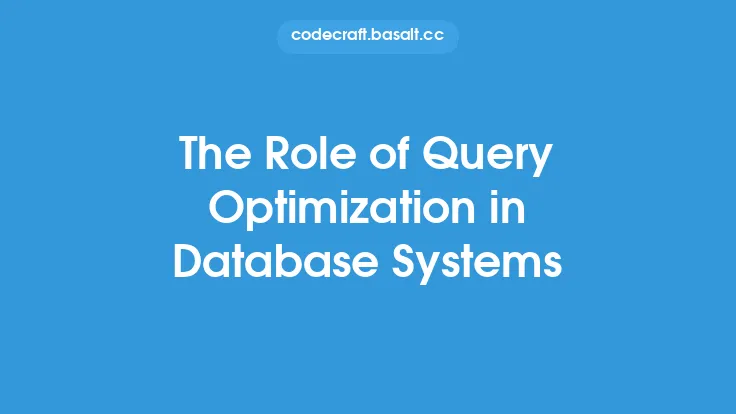Query optimization is a crucial aspect of database systems, as it directly impacts the performance and efficiency of data retrieval and manipulation. In today's data-driven world, databases are the backbone of most applications, and optimizing queries is essential to ensure fast and reliable data access. In this article, we will delve into the world of query optimization techniques, exploring the various methods and strategies that can be employed to improve database efficiency.
Introduction to Query Optimization
Query optimization is the process of analyzing and improving the execution plan of a query to minimize its execution time and resource usage. The goal of query optimization is to reduce the time it takes to retrieve or manipulate data, while also minimizing the load on the database server. This is achieved by selecting the most efficient execution plan, which involves choosing the optimal access methods, join orders, and aggregation techniques. Query optimization is a complex task, as it requires a deep understanding of the database schema, data distribution, and query patterns.
Understanding Query Optimization Techniques
There are several query optimization techniques that can be employed to improve database efficiency. One of the most effective techniques is to use efficient indexing strategies. Indexes can significantly speed up query execution by providing a quick way to locate specific data. However, indexes can also slow down write operations, so it's essential to carefully consider the indexing strategy. Another technique is to optimize join orders, which involves rearranging the order in which tables are joined to minimize the number of rows being joined. This can significantly reduce the execution time of complex queries.
Analyzing Query Execution Plans
To optimize queries, it's essential to analyze the query execution plan, which is the sequence of operations that the database performs to execute a query. The execution plan can be obtained using the EXPLAIN statement, which provides detailed information about the query execution, including the access methods, join orders, and aggregation techniques used. By analyzing the execution plan, developers can identify performance bottlenecks and optimize the query accordingly. For example, if the execution plan shows that a query is using a full table scan, an index can be created to speed up the query.
Using Hints and Directives
Hints and directives are special instructions that can be used to influence the query optimizer's decision-making process. Hints can be used to specify the desired access method, join order, or aggregation technique, while directives can be used to override the optimizer's decisions. For example, the USE INDEX hint can be used to specify the index to use for a query, while the FORCE INDEX directive can be used to force the optimizer to use a specific index. However, hints and directives should be used judiciously, as they can also lead to suboptimal query plans if not used correctly.
Leveraging Database Statistics
Database statistics play a crucial role in query optimization, as they provide the optimizer with information about the data distribution and query patterns. Accurate statistics can help the optimizer choose the most efficient execution plan, while outdated or inaccurate statistics can lead to suboptimal query plans. Database administrators should regularly update statistics to ensure that the optimizer has the most up-to-date information. Additionally, statistics can be used to identify skewed data distributions, which can impact query performance.
Avoiding Common Pitfalls
There are several common pitfalls that can impact query performance, including using SELECT \* instead of specifying the required columns, using functions in the WHERE clause, and using correlated subqueries. These pitfalls can lead to slow query execution, increased resource usage, and decreased database efficiency. Developers should avoid these pitfalls by using efficient query constructs, such as specifying the required columns, using indexes, and avoiding correlated subqueries.
Best Practices for Query Optimization
To optimize queries effectively, developers should follow best practices, such as using efficient indexing strategies, optimizing join orders, and analyzing query execution plans. Additionally, developers should use hints and directives judiciously, leverage database statistics, and avoid common pitfalls. By following these best practices, developers can significantly improve query performance, reduce resource usage, and increase database efficiency.
Advanced Query Optimization Techniques
There are several advanced query optimization techniques that can be employed to further improve database efficiency. One such technique is to use parallel query execution, which involves executing multiple queries concurrently to improve overall throughput. Another technique is to use query caching, which involves storing the results of frequently executed queries to reduce the load on the database server. Additionally, advanced indexing techniques, such as bitmap indexing and function-based indexing, can be used to improve query performance.
Conclusion
Query optimization is a critical aspect of database systems, and employing effective query optimization techniques can significantly improve database efficiency. By understanding query optimization techniques, analyzing query execution plans, using hints and directives, leveraging database statistics, avoiding common pitfalls, and following best practices, developers can optimize queries to achieve fast and reliable data access. Additionally, advanced query optimization techniques, such as parallel query execution and query caching, can be used to further improve database efficiency. By optimizing queries, developers can ensure that their applications provide a seamless user experience, while also reducing the load on the database server.





